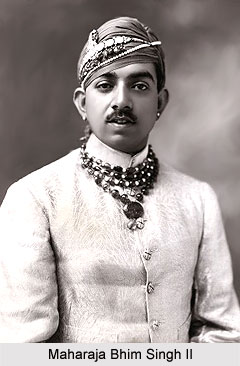 Bhim Singh II was the last ruling Maharaja of the princely state of Kotah, which is currently northern state of Rajasthan, India. He reigned over the territory from the year 1940 to 1947. Bhim Singh II was born on 14th September 1909; he was the only son and heir of Maharaja Sri Sir Umed Singh II. After the death of his father on 27th December 1940, he succeeded and ascended the royal throne of Kotah. Later, he joined the British Indian Army and served as an officer during the World War II. In the year 1948, he was promoted to the rank of major.
Bhim Singh II was the last ruling Maharaja of the princely state of Kotah, which is currently northern state of Rajasthan, India. He reigned over the territory from the year 1940 to 1947. Bhim Singh II was born on 14th September 1909; he was the only son and heir of Maharaja Sri Sir Umed Singh II. After the death of his father on 27th December 1940, he succeeded and ascended the royal throne of Kotah. Later, he joined the British Indian Army and served as an officer during the World War II. In the year 1948, he was promoted to the rank of major.
Rule of Bhim Singh II
Maharaja Bhim Singh II planned a number of programs for the development of education and progress of the region, which were successfully implemented after the contry achieved independence. He was knighted with the Knight Grand Commander of the Order of the Star of India (KCSI) in the year 1947, and signed the Instrument of Accession to the Dominion of India on the Indian Independence Day on 15 August of the same year. Kotah was merged with the Rajasthan Union of states by Sir Bhim Singh II on 25 March 1948. He was appointed as the first Rajpramukh, but was later demoted and became the Deputy Rajpramukh or Uprajpramukh, after the Maharana of Udaipur acceded to the Rajasthan Union, as he held a higher rank than Bhim Singh II. He continued to serve in the office of Deputy Rajpramukh until the office was abolish by the Indian Government on 31st October 1956.
Maharaja Bhim Singh II served as an Alternate Delegate to the United Nations General Assembly in 1956. Further more, from the year 1959, Singh was appointed as the President of the Rajasthan Board for the Preservation of Wildlife.
Personal Life of Bhim Singh II
Bhim Singh II was married to Rathorji Maharani Shivkumari Sahiba on 30th April 1930. She was the daughter of General Maharaja Sir Ganga Singh of Bikaner. The royal couple had two daughters and one son, Maharajkumari Indira Kumari Sahiba, Maharajkumari Bhuvaneshwari Kumari Sahiba and Maharajkumar Sri Brijraj Singhji Sahib Bahadur. Sir Bhim Singhji was stripped of ruling powers and titles under the Indira Gandhi regime in 1971. He died at the age of 81, on 20th July 1991 after a reign of 51 years. He was succeeded by Brijraj Singh, his only son, who ruled as Maharajadhiraj Maharaja Mahimahendra Maharao Raja Sri Brijraj Singh Sahib Bahadur.
Titles of Bhim Singh II
Bhim Singh II held many titles and styles through out his reign over Kotah-
* Maharajkumar Sri Bhim Singh Sahib Bahadur (1909- 1940)
* His Highness Maharajadhiraj Maharaja Mahimahendra Maharao Raja Sri Bhim Singh II Sahib Bahadur, Maharao Raja of Kotah (1940- 1943)
* Captain His Highness Maharajadhiraj Maharaja Mahimahendra Maharao Raja Sri Bhim Singh II Sahib Bahadur, Maharao Raja of Kotah (1943- 1944)
* Major His Highness Maharajadhiraj Maharaja Mahimahendra Maharao Raja Sri Bhim Singh II Sahib Bahadur, Maharao Raja of Kotah (1944- 1945)
* Lieutenant Colonel His Highness Maharajadhiraj Maharaja Mahimahendra Maharao Raja Sri Bhim Singh II Sahib Bahadur, Maharao Raja of Kotah (1945- 1946)
* Colonel His Highness Maharajadhiraj Maharaja Mahimahendra Maharao Raja Sri Bhim Singh II Sahib Bahadur, Maharao Raja of Kotah (1946- 1947)
* Colonel His Highness Maharajadhiraj Maharaja Mahimahendra Maharao Raja Sri Sir Bhim Singh II Sahib Bahadur, Maharao Raja of Kotah, KCSI (1947- 1948)
* Brigadier His Highness Maharajadhiraj Maharaja Mahimahendra Maharao Raja Sri Sir Bhim Singh II Sahib Bahadur, Maharao Raja of Kotah, KCSI (1948- 1991)
Honours of Bhim Singh II
Maharaja Bhim Singh II was honoured several times. These are mentioned below-
* King George V Silver Jubilee Medal (1935)
* King George VI Coronation Medal (1937)
* Ganga Singh Golden Jubilee Medal of Bikaner (1937)
* 1939- 1945 Star (1945)
* Africa Star (1945)
* British War Medal (1945)
* Knight Commander of the Order of the Star of India- KCSI (1947)
* Indian Independence Medal (1947)
* Arjuna Award (1971)



















